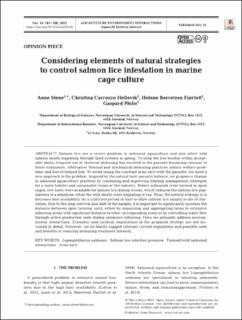| dc.contributor.author | Stene, Anne | |
| dc.contributor.author | Hellevik, Christina Carrozzo | |
| dc.contributor.author | Fjørtoft, Helene Børretzen | |
| dc.contributor.author | Philis, Gaspard | |
| dc.date.accessioned | 2023-01-31T10:25:09Z | |
| dc.date.available | 2023-01-31T10:25:09Z | |
| dc.date.created | 2022-10-21T09:36:56Z | |
| dc.date.issued | 2022 | |
| dc.identifier.citation | Aquaculture Environment Interactions. 2022, 14 181-188. | en_US |
| dc.identifier.issn | 1869-215X | |
| dc.identifier.uri | https://hdl.handle.net/11250/3047331 | |
| dc.description.abstract | Salmon lice are a severe problem in salmonid aquaculture and also affect wild salmon smolts migrating through fjord systems in spring. To keep the lice burden within acceptable limits, frequent use of chemical delousing has resulted in the parasite becoming resistant to these treatments. Alternative thermal and mechanical delousing practices induce welfare problems and loss of farmed fish. To avoid losing the constant arms race with the parasite, we need a new approach to the problem. Inspired by the natural host−parasite balance, we propose a change in salmonid aquaculture practices by combining and improving existing management strategies for a more holistic and sustainable vision of the industry. Before salmonids were farmed in open cages, few hosts were available for salmon lice during winter, which reduced the salmon lice populations to a minimum when the wild smolts were migrating to sea. Thus, the natural strategy is to decrease host availability for a sufficient period of time to allow salmon lice nauplii to die of starvation. Due to the long survival and drift of the nauplii, it is important to significantly increase the distance between open farming units, either by organising and aggregating farms in extensive fallowing areas with significant distance to other corresponding areas or by controlling water flow through active production units during extensive fallowing. Here we primarily address environmental interactions. Economic and juridical implications of the proposed strategy are not discussed in detail. However, we do briefly suggest relevant current regulations and possible costs and benefits of reducing delousing treatment intensity. | en_US |
| dc.language.iso | eng | en_US |
| dc.publisher | Inter-Research Science Publisher | en_US |
| dc.rights | Navngivelse 4.0 Internasjonal | * |
| dc.rights.uri | http://creativecommons.org/licenses/by/4.0/deed.no | * |
| dc.title | Considering elements of natural strategies to control salmon lice infestation in marine cage culture | en_US |
| dc.title.alternative | Considering elements of natural strategies to control salmon lice infestation in marine cage culture | en_US |
| dc.type | Peer reviewed | en_US |
| dc.type | Journal article | en_US |
| dc.description.version | publishedVersion | en_US |
| dc.source.pagenumber | 181-188 | en_US |
| dc.source.volume | 14 | en_US |
| dc.source.journal | Aquaculture Environment Interactions | en_US |
| dc.identifier.doi | 10.3354/aei00436 | |
| dc.identifier.cristin | 2063538 | |
| cristin.ispublished | true | |
| cristin.fulltext | original | |
| cristin.qualitycode | 1 | |

